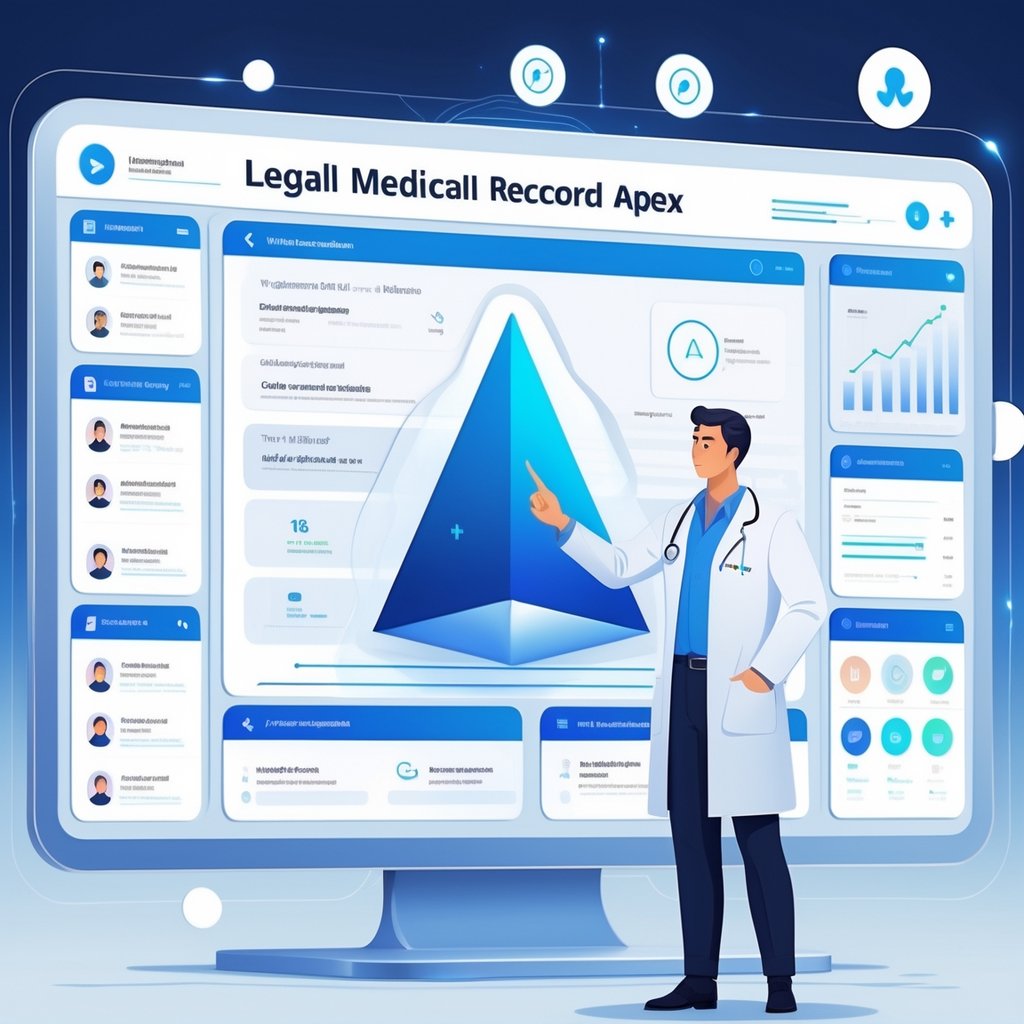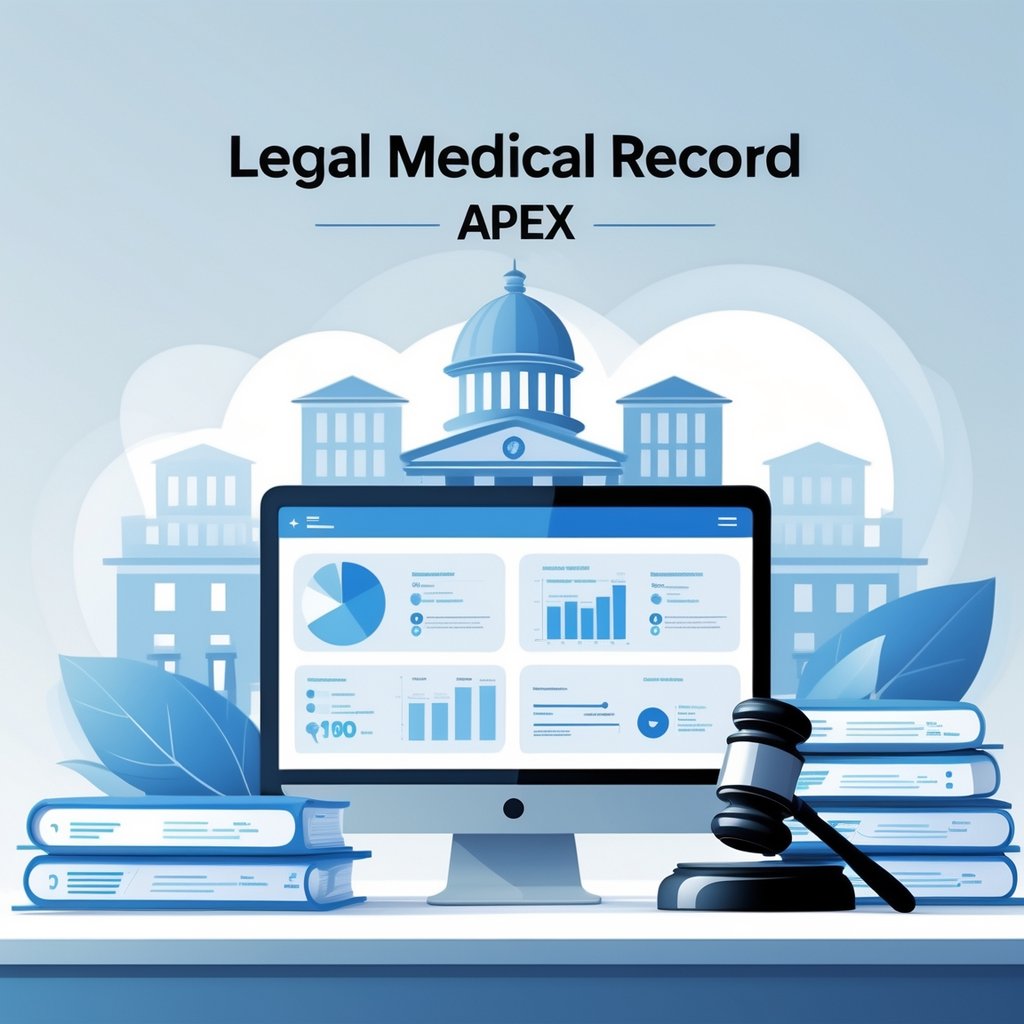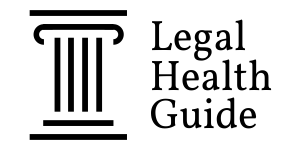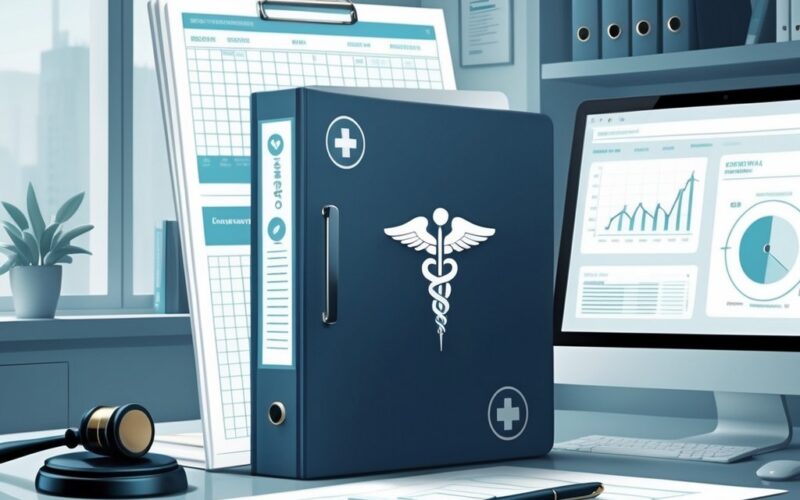A legal medical record is the official documentation that healthcare providers keep and share during legal cases, regulatory checks, or when a patient asks for it.
A legal medical record apex is the full, court-admissible set of all patient health information that meets the strictest legal and regulatory standards. It covers not just the usual medical chart, but also electronic data, audit trails, and supporting documents that can stand up to legal challenges.

Figuring out what counts as a legal medical record gets tricky as healthcare goes digital.
The old paper chart has turned into a complex mix of electronic health records, discoverable documents, and all kinds of patient data spread across different systems.
Healthcare organizations have to juggle federal rules, state laws, and accreditation standards to make sure their records meet legal requirements.
The pressure to keep proper legal medical records is intense.
If healthcare providers don’t preserve or produce the right documentation, they risk legal trouble, sanctions, or even losing in court.
Your provider’s ability to define and maintain the legal medical record affects both patient care and legal protection for everyone involved.
Key Takeaways
- Legal medical records must include clinical documentation and discoverable electronic information that meets regulatory standards
- Healthcare organizations face serious legal consequences if they fail to properly maintain and produce required medical record documentation
- Modern legal medical records cover much more than paper charts, including electronic data, audit logs, and digital formats
Defining a Legal Medical Record Apex

A legal medical record apex sets the highest bar for documentation. It meets all regulatory, legal, and clinical requirements.
This record combines full patient information with strong authentication protocols. The goal is a defensible record for any legal proceeding.
Core Characteristics
A legal medical record apex stands apart from regular documentation because of its specific features.
The legal medical record serves as the organization’s complete business record across all care settings.
Your apex record needs authenticated entries with signatures, dates, and timestamps. Each document should show who created it.
It must cover patient demographics, medical history, and treatment documentation.
Detailed progress notes are necessary to back up medical decisions and treatment plans.
Essential components include:
- Admission and discharge summaries
- Physician orders and medication records
- Laboratory and diagnostic test results
- Informed consent forms
- Operative reports when needed
Electronic health records have added complexity to record-keeping. The apex standard must include audit trails and system metadata.
Distinctions from General Medical Records
Your legal medical record apex is different from routine medical records in both scope and purpose.
The legal medical record is a subset of the designated record set assembled for legal use.
General medical records help with clinical care and coordination. The apex record focuses on legal defensibility and court compliance.
You need stricter retention policies for the apex standard. These records stick around longer, depending on state law and the risk of lawsuits.
Key differences include:
| Legal Medical Record Apex | General Medical Records |
|---|---|
| Court-ready format | Clinical workflow focus |
| Extended retention | Standard retention |
| Complete authentication | Basic documentation |
| Audit trail preservation | Limited tracking |
Discovery rules now cover electronically stored information, so preserving all data is a must.
Purpose and Role in Healthcare
Your legal medical record apex does a lot in healthcare operations.
The roles include supporting care decisions and documenting services as legal testimony about patient treatment.
The apex record protects your organization during malpractice claims. It offers proof of appropriate care standards and clinical decision-making.
You use this record to show compliance with regulations. Joint Commission and CMS standards demand certain documentation for accreditation and payment.
Primary purposes:
- Legal protection during lawsuits
- Regulatory compliance for audits
- Quality assurance documentation
- Billing justification for services
Healthcare organizations must define uniform standards for what goes in the legal medical record. The apex standard keeps responses to legal requests consistent.
Components of the Legal Medical Record Apex

The legal medical record apex has three main components that anchor patient documentation.
You need patient identification data, a full medical history with progress notes, and all diagnostic test records with results.
Patient Identification and Demographics
Your legal medical record starts with accurate patient identification.
This info grounds all other medical documentation.
Core identification elements include:
- Full legal name and any aliases
- Date of birth and age
- Social Security number
- Current address and contact information
- Emergency contact details
You have to check this information at every visit.
Insurance information matters, too. Your record should include current insurance provider details, policy numbers, and proof of coverage.
Joint Commission standards ask for race and ethnicity data. Language preferences also need to be noted for clear communication.
Don’t forget to include advance directives or healthcare proxy information.
Medical History and Progress Notes
Your patient record needs a comprehensive medical history that tells the whole clinical story.
This section is the narrative backbone of care.
Essential medical history components:
- Chief complaint and present illness
- Past medical and surgical history
- Current medications and allergies
- Family and social history
- Review of systems
Progress notes track the course of care. You must include physician assessments, treatment plans, and how the patient responds.
Nursing documentation adds ongoing monitoring. These notes cover vital signs, medication administration, and changes in patient status.
Every entry should have a date, time, and provider ID. Your notes need to show clinical decision-making and explain treatment choices.
Diagnostic Tests and Results
This section gathers all lab results, imaging studies, and special procedures from patient care.
These records give objective data to back up medical decisions.
Laboratory results must include:
- Complete blood counts and chemistry panels
- Microbiology cultures and sensitivity reports
- Pathology findings and interpretations
- Reference ranges for all values
Imaging studies need both the images and the radiologist’s written interpretation.
You should keep radiology films, scans, and digital images as part of the permanent record.
Special diagnostic procedures require full documentation. This covers EKGs, pulmonary function tests, and cardiac catheterizations with their reports.
Your record should connect test results to treatment decisions. If there are abnormal findings, document follow-up and provider acknowledgment.
Regulatory and Legal Standards

Medical records have to follow strict rules from federal laws and healthcare standards.
HIPAA privacy rules set the baseline for how your health information gets protected and shared.
State and federal laws add more requirements for record keeping.
HIPAA and the Privacy Rule
HIPAA lays out the main rules for keeping your health information safe.
The Privacy Rule gives you rights over who can see your medical data.
Under HIPAA, you can request copies of your medical records. Providers have 30 days to respond.
The Privacy Rule limits who can view your info without your say-so. Only people like your doctors, nurses, and billing staff can access these records.
Healthcare facilities have to train staff on HIPAA rules. They must use security steps to keep your records safe from snooping.
Key HIPAA protections include:
- Right to get your own records
- Control over who sees your information
- Notice when records are shared
- Ability to request corrections
Federal and State Legal Requirements
Federal and state laws create a complex framework for managing medical records.
These rules work together to protect patients and make sure documentation is proper.
Federal rules include Medicare documentation standards. Providers have to keep detailed records to back up billing and care decisions.
State laws often add extra rules about how long to keep records. Some states require records to stick around for a set number of years after treatment ends.
Professional licensing boards set standards for documentation, too. Doctors and other healthcare workers need to follow these rules to keep their licenses.
Common legal requirements:
- Minimum retention periods
- Documentation accuracy standards
- Patient access rights
- Security and privacy requirements
Designated Record Set
The designated record set includes all records used for medical decisions and billing.
This is a bigger set than just the legal medical record used in court.
Your designated record set covers medical charts, test results, and billing records. It also includes appointment schedules and treatment plans that affect care.
Providers must decide what goes in each patient’s designated record set. This helps them respond to record requests and legal cases the right way.
The legal medical record is a smaller chunk of the designated record set. It only has the documents needed for court or formal requests.
| Record Type | Purpose | Contents |
|---|---|---|
| Designated Record Set | All care and billing decisions | Complete patient files |
| Legal Medical Record | Court proceedings and formal requests | Essential documentation only |
Electronic Legal Medical Records

Electronic systems have changed how healthcare organizations make, store, and manage legal medical records.
Modern electronic health records come with full audit features and stronger data integrity than old paper systems.
Transition from Paper to Electronic Records
The move from paper to electronic records started with the Health Information Technology for Economic and Clinical Health Act in 2009.
This law pushed healthcare providers to document and store patient info digitally.
Now organizations collect way more data than before. Electronic systems track user access, timestamps, and system changes automatically.
This makes for a more complete record of patient care.
Electronic medical record systems integrate data from multiple sources and capture information right at the point of care.
They help providers make decisions with real-time access to patient data.
The electronic format lets you store all kinds of information. You can keep text documents, images, audio, and even video files in one place.
Key Features of Electronic Records
Electronic health records include the same core clinical info as paper records, but with extra features. The system generates timestamps for every entry and change.
Standard electronic record components include:
- Patient demographics and identifiers
- Clinical notes and assessments
- Medication records and orders
- Laboratory and radiology results
- Treatment plans and procedures
Multiple users can access the same record at once. This makes care coordination easier for different providers working with the same patient.
Your electronic record links related info automatically. Lab results connect to the original orders. Medications show up with the conditions they treat.
The system keeps version control for all documents. You can see who made changes and when. This builds a complete audit trail of the record’s history.
Audit Trails and Data Integrity
Electronic systems now track who accesses patient records, when, and from where. Paper charts never had this level of audit info, but now it’s standard for the legal medical record.
Audit logs capture every user interaction with the record. The system records the exact time and user identity for each action, including viewing, editing, printing, and sharing.
Audit trails typically include:
- User login and logout times
- Record access attempts
- Data modifications and deletions
- System errors or security breaches
These logs act as legal evidence in court. Attorneys request audit trail info to see how records were handled. Medical records must be maintained in a legally sound way or they risk being challenged as invalid.
Your organization has to preserve electronic info that might matter in future legal cases. Failing to maintain audit trails and electronic data can bring sanctions for evidence destruction.
Access, Disclosure, and Retention Policies

Healthcare providers follow strict rules about who can access medical records, when info can be shared, and how long records stick around. Legal frameworks governing access to medical records protect patient privacy while making sure providers do their jobs.
Patient Rights and Access
You have the legal right to see your own medical records. Most healthcare providers must respond to your written request within 30 days.
Your access rights include:
- Viewing your complete medical record
- Getting copies of your records
- Requesting corrections to inaccurate info
- Receiving records in electronic format if possible
Providers can charge reasonable fees for copying. They can’t deny access just because you owe money for services. You might need to pay for copies before you get your records.
Some access limits exist. Mental health records may have restrictions. Records tied up in legal cases might be off-limits for a while.
You can authorize others to access your records. This could be family, attorneys, or healthcare providers involved in your care.
Authorizations and Disclosures
Healthcare providers need your written permission before sharing your medical records with most third parties. The authorization has to spell out what info will be shared and with whom.
Required authorization elements include:
- Description of info to be disclosed
- Purpose of the disclosure
- Who will get the info
- Your signature and date
- Expiration date or event
Some disclosures don’t need your OK. These include treatment, payment, and certain public health activities. Emergencies can also allow disclosure without your permission.
Insurance companies often want medical records for payment decisions. You’ll usually sign broad authorizations when applying for coverage or filing claims. It’s smart to check what you’re agreeing to.
Providers must track all disclosures of your info. You can ask for a list of these disclosures for the past six years.
Record Retention and Destruction
Medical record retention requirements make sure providers keep accurate records for compliance and legal protection. Retention periods change depending on state and record type.
Common retention periods:
- Adult records: 5 to 10 years after last treatment
- Minor records: Until age of majority plus extra years
- Mental health records: Sometimes longer required
- Diagnostic images: Usually 5 to 7 years
Medical records retention laws by state mean requirements aren’t the same everywhere. Providers in more than one state have to follow the strictest rules.
Electronic records follow the same retention rules as paper. Providers must keep electronic systems working and records intact for the full retention period.
After the time’s up, providers must destroy records securely. That means shredding paper and permanently deleting electronic files. HIPAA compliance and medical records storage demands secure destruction so no one can get to the info later.
Some records might need to be kept longer for legal or research reasons.
Significance of Legal Medical Record Apex in Clinical and Legal Contexts

Legal medical records are critical evidence in court and help maintain patient care across providers. They also protect against liability claims and help organizations manage clinical risk.
Evidence in Legal Proceedings
Medical records play a crucial role in various legal contexts, especially malpractice and personal injury cases. Your record becomes the main evidence courts look at to decide if care was proper.
The accuracy and completeness of your records can tip the scales in legal cases. Any discrepancies or omissions can significantly impact the credibility of claims or defenses during litigation.
Courts use your documentation to establish:
- Standard of care for patients
- Timeline of treatment and decisions
- Patient consent for procedures
- Communication among providers
Your legal record can be certified in court as authentic. This process makes sure records meet legal standards for evidence.
Supporting Treatment and Continuity of Care
Medical records are the foundation for ongoing patient treatment. They hold info that guides decisions and keeps care safe.
Treatment planning relies on accurate documentation of previous interventions, meds, and patient responses. Records help prevent drug interactions and duplicate procedures.
When patients move between facilities, medical records provide key info like:
- Current medications and dosages
- Allergies and adverse reactions
- Recent test results and procedures
- Treatment plans and discharge instructions
Thorough and accessible documentation improves continuity of care. Providers can make informed choices fast, especially in emergencies.
Risk Management Considerations
Medical records are your main defense against malpractice claims and regulatory trouble. Good documentation shows you followed protocols and gave proper care.
Incomplete or inaccurate records create big legal risks. Missing notes can make it look like care wasn’t given, even if it was.
Key risk management benefits include:
| Protection Area | How Records Help |
|---|---|
| Malpractice defense | Document standard care provision |
| Regulatory compliance | Show adherence to requirements |
| Quality assurance | Track patient outcomes |
| Insurance claims | Verify medical necessity |
Your documentation affects insurance coverage and reimbursement. Poor records can mean denied claims and lost revenue.
Regular audit and review of records can catch problems before they become legal headaches. Staying proactive protects everyone involved.
Frequently Asked Questions

Healthcare providers deal with a lot when it comes to creating and managing legal medical records. Here are some real-world questions about criteria, maintenance, and compliance for patient documentation.
What are the criteria that constitute a legal medical record in a healthcare setting?
Your legal record must include all documentation of services provided. This means patient identifiers like name and address, plus info that backs up diagnosis and treatment.
The Joint Commission requires specific elements in a complete medical record. Demographics, clinical data, advance directives, and informed consent forms all count.
Your record should have a medical history and physical exam. You also need to list admitting diagnosis, complications, and any bad reactions to drugs or anesthesia.
Federal rules say records must justify admission and continued hospitalization. The documentation must support the diagnosis and describe the patient’s progress and response to meds.
How is a legal medical record maintained and preserved according to compliance requirements?
You need documented policies that define your legal medical record and its contents. Use the same terms in all departments and systems.
Federal and state rules govern retention requirements for different types of info. Know where each record type is stored and how to find it.
Electronic records add more challenges. You have to keep audit logs that track who accesses records, when, and where.
Losing electronic info can lead to spoliation sanctions. Take reasonable steps to preserve anything that might matter in future legal cases.
What information should be included in a patient’s legal medical record?
Your patient’s record needs all provider orders and nurses’ notes. Also include treatment reports, medication records, radiology results, and lab reports.
CMS regulations specify that records must have vital signs and other info needed to monitor patient condition. Discharge summaries and final diagnoses are required too.
Include any communication with patients, like phone calls or emails. Text messages and emails to patients are part of the legal record.
Document surgical procedures, including provisional diagnosis, operative reports, and post-op care. Anesthesia records and recovery unit discharge notes are needed as well.
What measures must be taken to ensure the confidentiality and security of legal medical records?
You have to follow HIPAA privacy rules with patient records. Patients need explicit written authorization for attorneys to get their records in legal cases.
Electronic systems should have access controls to track who views patient info. Audit logs keep people accountable and spot unauthorized access.
Physical records need secure storage with limited access. Set policies for who can see records and when.
Staff training on confidentiality is a must. Everyone who handles records should know their legal duty to keep info private.
What are the legal implications of electronic medical records versus paper records?
Electronic records create way more discoverable info than paper charts. Federal courts have amended rules to address electronic discovery.
Your systems track access, timestamps, and user activity automatically. Attorneys can request this audit trail for legal cases.
Electronic records have metadata that paper never had. This hidden info shows when documents were created, changed, or accessed.
Electronic records bring a bigger risk of spoliation sanctions. Courts expect you to keep electronic info that might matter in lawsuits.
How does a healthcare provider correct an error in a legal medical record without violating legal standards?
Never alter or destroy the original entries in medical records. Patients can request amendments if they spot something wrong in their records.
To fix an error, just draw a single line through it. Add the correct information nearby, then initial and date the change.
Electronic records work a bit differently. You need to follow amendment procedures that keep the original entry intact.
Your system should create an audit trail showing exactly what changed and when. Respond to patient amendment requests as HIPAA requires.
If you deny a request, you have to give the patient info about their appeal rights. That’s just part of the deal.












